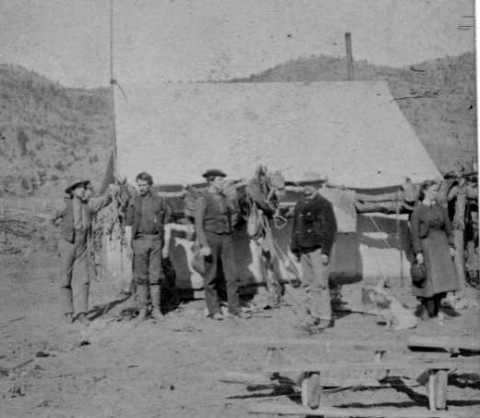Dublin Core
Title
Description
Starting in the 1840s, government explorers began to survey and map the Intermountain West more thoroughly. Meet Leonard Swett, a wealthy young man from Chicago who came West with the U.S. Geological Survey.
Among the first government workers in Utah were the members of early exploratory expeditions who catalogued the topography, flora, fauna, and natural resources of the West. In 1879, Leonard Swett came to Utah as part of a U.S. Geological Survey team that was conducting scientific studies of the Colorado Plateau from its base camp in Kanab. Just 21-years old, Swett was “a good mathematician,” but got the job through his father’s connections. His letters home convey the workings of a scientific expedition and illustrate how field work in the West wasn’t just about the job.
Swett described for his parents how much labor went into simply getting team members to their research sites. “Everybody is very busy,” he wrote, “…shoeing mules, jerking beef, overhauling tents, saddles, [and] blankets...” In the field, Swett spent six to twelve hours a day making climate observations. He recorded barometer and thermometer readings, and had “charge of an instrument for noting the force and direction of the winds.” He also recorded “the percentage of clouds in the sky and their species.”
Utah’s mountains, lakes, deserts, soil, and aridity constantly featured in Swett’s letters, showing the profound role they played in his day-to-day experience. Indeed, the environment changed his very appearance. “I fear you would not know [your] boy, so rapidly he is changing to a frontier dandy,” he told his parents. “[I have] a nose peeled with the heat, lips cracked, hands brown, and lumps of hair standing at irregular intervals all over [my] face.” Swett also changed his attire to blend in. He wore “high boots with high Mexican spurs, pants with a buckskin seat [and] trimming…; a blue shirt, gray duck jacket…; and to complete the suit a broad brimmed, white felt hat with buckskin strings to tie under the chin…, [for] when the wind blows.”
Leonard Swett apparently enjoyed the job – not to mention the adventure – since he returned the following year to resume his work.
Creator
Matthew Basso for Utah Humanities © 2017
Source
Image: Powell Expedition. Photograph of the tent in Kanab, Utah, where the first map of the Grand Canyon was made during the Powell Expedition. Members of these exploratory expedition groups were some of the first government workers in Utah. Photograph taken by Frederick S. Dellenbaugh. 1871. Courtesy of American Geographical Society of New York.
_______________
See Dove Menkes, “A Young Man Goes West: The 1879 Letters of Leonard Herbert Swett,” Utah Historical Quarterly 75, no. 3 (2007), pp. 204-220; Matthew Basso, The Way Utah Worked, Salt Lake City: Utah Humanities, 2017.

